

Platform as a Service team takes even-handed approach to meetings. We’ve all been in group situations where the discussion is dominated by the most confident or the loudest people in the room.

The less dominant or newer members of the group hesitate to voice their opinion. Others get distracted waiting for the right moment to jump in, only to find that when there is a chance to speak, the conversation has already moved on. We’ve all interrupted or been interrupted. In my experience, people don’t dominate a conversation or interrupt others because they are unkind or power-hungry.
It usually happens because they’re passionate. Stephen Hawking said: “Quiet people have the loudest minds”. Browse guides by topic — Government Service Design Manual. Service design phases — Government Service Design Manual. Accessible Media Player by Nomensa The timeline slider below uses WAI ARIA.

Please use the documentation for your screen reader to find out more. Building a digital service is a complex task, with many risks. By breaking development into phases you minimise risk, learning about what works and what doesn't, iterating as you go. As the service progresses through development you'll find out more about users' needs, development requirements and the conditions your service will be operating in. This approach allows the team making and operating the service to start small, learn fast, and provide value to users as soon as possible. When content design meets service design. What we mean by service design. Leeds GovJam. Most of government is mostly service design most of the time. Discuss. – Matt Edgar writes here.
Without exception, everyone I meet in the public sector wants to help make their service better.
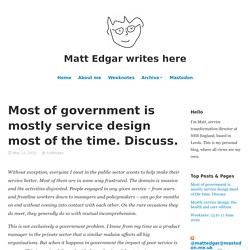
Most of them are in some way frustrated. The domain is massive and the activities disjointed. People engaged in any given service – from users and frontline workers down to managers and policymakers – can go for months on end without coming into contact with each other. On the rare occasions they do meet, they generally do so with mutual incomprehension. This is not exclusively a government problem. GOV.UK – GDS design principles.
Features of agile — Government Service Design Manual. Some common features of the agile development methods we’ve used at GDS.

Sprints Sprints are about planning what you and your team will achieve and when you will achieve it by. Each member of your team should have a task to complete within each sprint. Each sprint is of equal length and usually lasts between 1 to 2 weeks, but you can use longer or shorter sprints in your project. When deciding the length of your sprints, consider: the length of the project – use shorter sprints for shorter projects, giving you greater visibility of what’s going on, the opportunity to iterate and the flexibility to adaptively plan team members that are new to the Scrum process: shorter sprints means those that are new to Scrum get used to the regular meeting formats and processes faster how often you release code to production - if it’s only released at the end of each sprint decide how often do you want to ship production-ready code Start the process with a sprint 0.
Standard meetings Daily stand-up. Testing in an agile environment — Government Service Design Manual. The basics of any testing approach still apply in the agile world, but the aim of testing can be quite different.
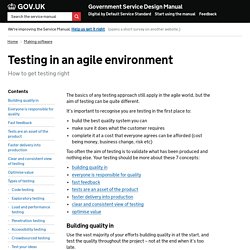
It’s important to recognise you are testing in the first place to: build the best quality system you can make sure it does what the customer requires complete it at a cost that everyone agrees can be afforded (cost being money, business change, risk etc) Too often the aim of testing is to validate what has been produced and nothing else. Your testing should be more about these 7 concepts: Building quality in. Running retrospectives — Government Service Design Manual. A central principle of agile is quick feedback loops – you demonstrate something to the user as soon as possible so you can see how well it suits their needs.
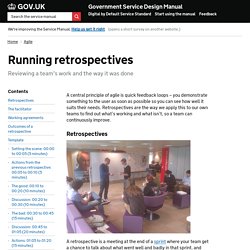
Retrospectives are the way we apply this to our own teams to find out what’s working and what isn’t, so a team can continuously improve. Retrospectives A retrospective is a meeting at the end of a sprint where your team get a chance to talk about what went well and badly in that sprint, and take some actions to improve matters. It can also cover a larger scope, eg a full project retrospective. A retrospective takes this form:
Writing user stories — Government Service Design Manual. A user story briefly explains: the person using the service (actor) what the user needs the service for (narrative) why the user needs it (goal) User stories are an essential part of the agile toolkit.
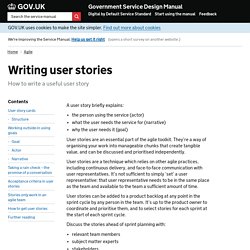
They’re a way of organising your work into manageable chunks that create tangible value, and can be discussed and prioritised independently. User stories are a technique which relies on other agile practices, including continuous delivery, and face-to-face communication with user representatives. It’s not sufficient to simply ‘set’ a user representative: that user representative needs to be in the same place as the team and available to the team a sufficient amount of time. User stories can be added to a product backlog at any point in the sprint cycle by any person in the team. Discuss the stories ahead of sprint planning with: relevant team members subject matter experts stakeholders User story cards A user story is represented through a story card that has a title and a few lines of text.
Running retrospectives — Government Service Design Manual. Features of agile — Government Service Design Manual. Some common features of the agile development methods we’ve used at GDS.
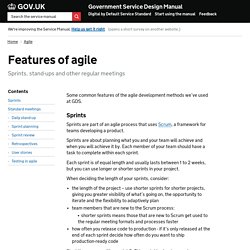
Sprints Sprints are about planning what you and your team will achieve and when you will achieve it by. Each member of your team should have a task to complete within each sprint. Each sprint is of equal length and usually lasts between 1 to 2 weeks, but you can use longer or shorter sprints in your project. Digital by Default Service Standard — Government Service Design Manual. The Digital Service Standard has changed from 26 points to a more concise 18.
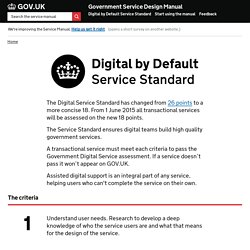
From 1 June 2015 all transactional services will be assessed on the new 18 points. The Service Standard ensures digital teams build high quality government services. A transactional service must meet each criteria to pass the Government Digital Service assessment. If a service doesn’t pass it won’t appear on GOV.UK. Assisted digital support is an integral part of any service, helping users who can't complete the service on their own. Understand user needs. Documenting how you work. Mapping work processes with DWP’s Personal Independence Payments team Agile isn’t something you do, it’s something you are.
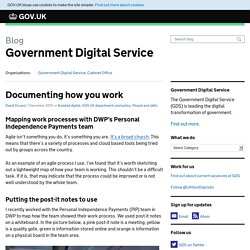
It’s a broad church. This means that there’s a variety of processes and cloud based tools being tried out by groups across the country. As an example of an agile process I use, I’ve found that it’s worth sketching out a lightweight map of how your team is working. This shouldn’t be a difficult task. Putting the post-it notes to use I recently worked with the Personal Independence Payments (PIP) team in DWP to map how the team showed their work process. Why documenting work was useful.